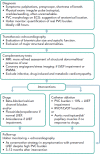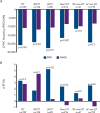Premature Ventricular Complex-induced Cardiomyopathy
- PMID: 29967685
- PMCID: PMC6020182
- DOI: 10.15420/aer.2018.23.2
Premature Ventricular Complex-induced Cardiomyopathy
Abstract
Premature ventricular complex-induced cardiomyopathy is a potentially reversible condition in which left ventricular dysfunction is induced by the occurrence of frequent premature ventricular complexes (PVCs). Various cellular and extracellular mechanisms and risk factors for developing cardiomyopathy in this context have been suggested but the exact pathophysiological mechanism remains unclear. The suppression of PVCs is usually indicated in symptomatic patients with frequent PVCs and also those with left ventricular dysfunction. Antiarrhythmic drugs are a useful non-invasive treatment to eliminate PVCs, but the side effect profile, including the risk of pro-arrhythmia, along with suboptimal clinical effectiveness, should be weighed against the usually more effective but not risk-free treatment with catheter ablation. The latter has progressively become first line therapy in many patients with PVC-induced cardiomyopathy and should be particularly considered in specific scenarios.
Keywords: Premature ventricular complex,; antiarrhythmic drug;; arrhythmia;; cardiomyopathy,; heart failure;; non-sustained ventricular tachycardia; outflow tract;; palpitations;; radiofrequency catheter ablation;; ventricular dysfunction,.
Conflict of interest statement
Disclosure: The authors have no conflicts of interest to declare.
Figures
References
Publication types
LinkOut - more resources
Full Text Sources
Other Literature Sources



